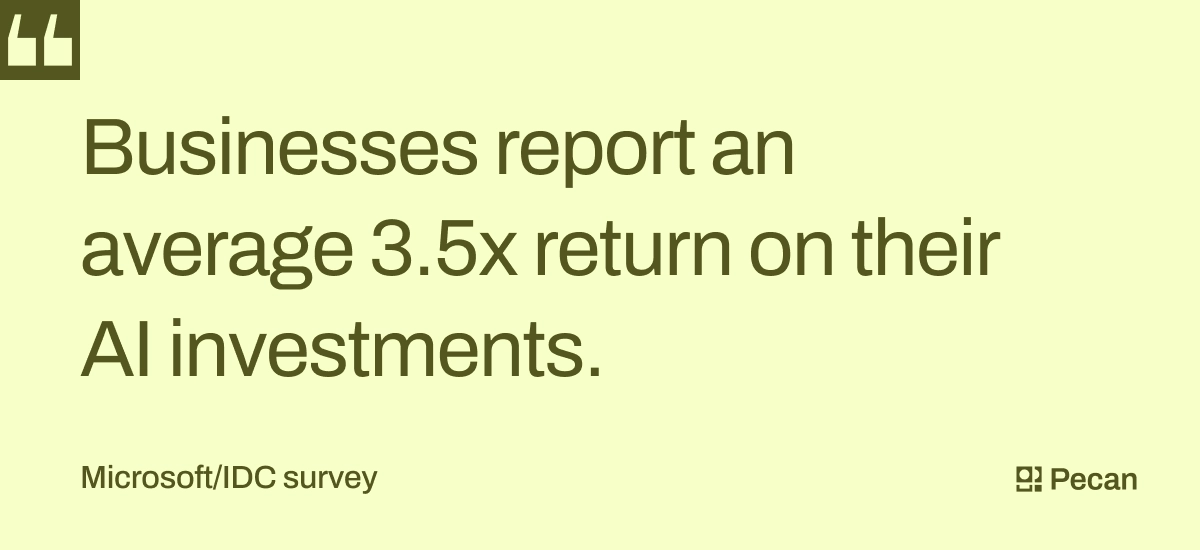In a nutshell:
- Investing in AI can lead to significant cost savings and revenue growth for your organization.
- Predictive analytics can help optimize various business areas such as supply chain, CRM, energy efficiency, HR, fraud detection, operational efficiency, IT operations, and financial planning.
- Low-code platforms bridge the talent gap between analysts and data scientists, saving time and money on manual processes.
Fences are notoriously tricky to sit on — especially if that position isn’t by choice. Should you invest in AI, and if so, which solutions? And what if you can’t get approval?
As a data leader, it’s your responsibility to lead your organization’s data and analytics transformation, which means you need to be strategic about which providers you invest in.
While GenAI solutions can create new data based on their training data, predictive AI can ingest data from across your organization — finance, sales, IT, marketing, customer support, and everywhere else — to turn it into highly predictive insights that will help your employees make data-driven decisions.
The good news is you don’t have to choose between the two. Pecan offers a Predictive GenAI platform that lets users quickly build and iterate machine learning models (predictive and prescriptive analytics) with the ease of natural language (Generative AI). Through a simple chat-based interface, users can dialogue with an AI assistant to define a business problem, determine relevant features, generate SQL, and build a functioning AI model — in minutes.
But the question remains: is the investment worth it?
In this blog, we break down the business impact of low-code Predictive GenAI platforms like Pecan and how they can help your business make and save money across eight business areas.
Revenue and cost-savings: Two sides of the same coin
Your top-line revenue is the money your organization generates (gross revenue), whereas your company’s bottom line is what they walk away with after costs and expenses. Low-code Predictive GenAI platforms can help improve both.
Top-line revenue
At a high level, predictive analytics can help your organization make money and capture market share that isn’t possible otherwise. You can answer questions such as: How is customer sentiment shifting? Which products should we create next? And how do we stop this customer from churning?
Low-code platforms and generative AI are accelerants that can help your workers do more with less. For example, our platform automates data preparation and cleaning, one of the most time-consuming aspects of the data analytics process; likewise, our GenAI capabilities help users quickly build and iterate SQL-based models multitudes faster than manual data science. With these time savings, your team can not only produce more insights but also focus their time on more strategic activities.
-

- For every $1 a company invests in AI, it realizes an average of $3.50 in ROI.
Bottom-line cost-savings
Low-code Predictive GenAI platforms also help your business save major costs when it comes to operating expenses and the opportunity cost of not using a platform.
The talent gap
Data science talent has become increasingly expensive and scarce in recent years. With guided machine learning and low-code capabilities, our low-code platform can bridge the gap between analyst and data scientist, helping your analysts build machine learning models with SQL knowledge and empowering your data scientists to focus their expertise rather than waste hours on manual data science processes.
The platform advantage
Cost savings also come about through the efficiency of a platform. Pecan handles all your data preparation and the entire model-building process — with the ease of generative AI. One solution for all your analytic needs.
Rather than investing in a handful of point solutions, investing in a platform that easily integrates with all your data sources helps you go live faster and avoid the risk of downtime or misalignment between solutions.
These are some high-level ways predictive analytics can help you save and make money. Now, let’s take a look at specific opportunities for cost-savings across eight different business areas.
-

- 8 areas for cost savings with predictive analytics
1. Supply chain optimization
Understanding how different economic and social factors affect demand and inventory levels is the bread and butter of supply chain analysts, and it stems from machine learning models. With predictive analytics, your supply chain team can optimize inventory levels to avoid stock-outs or overstock conditions, ensuring your team doesn’t lose money from having too much or too little inventory.
Your team can even use predictive analytics to forecast maintenance needs long before a disruptive breakdown occurs in your machinery. Maintenance costs go down while productivity peaks. Even better, well-taken care of machines will have a longer lifespan.
“We improved forecast accuracy in our seasonal business, and we have a deeper understanding of the variables that may influence a customer demand signal.”
— Bertrand Klehr, VP Supply Chain, Johnson & Johnson Consumer Health North America
2. Customer relationship management (CRM):
98% of organizations believe in the benefits of personalization to their larger business strategy or have made it core to their CX (customer experience) operations. Customers want a personalized experience — and predictive analytics can help provide it.
With Pecan, your marketing team can isolate your highest-value customers and build tailored campaigns that increase conversions. Predictive AI even offers insight into strategic cross-selling and upselling opportunities that are relevant to customers.
Your sales team can better channel their time with lead-scoring models, focusing on the highest value, most interested leads first, and your customer success team can spot early warning signs of churn to take preemptive action.
SciPlay, a leading mobile entertainment provider, needed a better way to nudge players to return to their games. After implementing Pecan, they created a data-centered, efficient process for ad retargeting and personalization, saving millions per year.
“Pecan allows us to be more profitable and invest better. We are definitely able to buy smarter than we used to, and it’s becoming a competitive edge.”
— Evyatar Livny, VP of Marketing Technology, SciPlay
3. Energy efficiency
Hand in hand with machine maintenance, energy is a major cost for manufacturing and industrial processes. Predictive analytics can help manufacturers save money not only by optimizing machine uptime but also by forecasting peak energy usage times.
With these insights, teams can optimize their production schedules around when energy is cheapest and most abundant. In CPG, predictive analytics can even help optimize routes and schedules to reduce fuel consumption and emissions.
4. Human resources
Predictive analytics can help inform and improve the entire talent lifecycle, from helping select candidates with the most potential to crafting employee retention strategies. For example, your team can improve workforce planning and talent acquisition by analyzing the characteristics of past employees to identify key traits that led to success. You can even examine rising skills in the marketplace to predict which skills your organization may need in the future.
Predictive HR analytics can even forecast future staffing needs based on turnover rates, forecasted growth, and market trends. Just like with customer churn, you can also develop employee retention strategies by analyzing patterns and factors that affect employee turnover.
5. Fraud detection
In the U.S., an estimated $308.6 billion is lost annually to insurance fraud. Predictive analytics is the antidote, dramatically improving fraud detection by flagging anomalous activity in real time.
Coinmama, a leading cryptocurrency exchange platform, needed a way to reduce chargebacks and identify fraudulent transactions. Before using Pecan, they would use custom-written, manual SQL scripts to apply static rules to new transactions—with limited results. But after implementing Pecan, they were able to generate accurate predictions for thousands of transactions per week while reducing the number of manual reviews by two-thirds.
“We’ve reduced our rate of false positives by about two-thirds and are now manually reviewing a much smaller list of transactions. Pecan gives us the ability to prioritize that list as well, so we can tend to the riskiest customers first.”
— Tammy Rotem, Data Analyst, Coinmama
6. Operational efficiency
Predictive analytics can help you optimize just about anything, whether resource allocation, machine usage, marketing campaigns, or workforce planning. A great example of this is a tier II supplier for some of the world’s largest manufacturers, who optimized their supply and demand forecasting through predictive analytics.
Before adopting Pecan, they had inaccurate forecasts that made it difficult to determine the number of subcomponents they needed to manufacture across their products. The demand/supply mismatch led to the understock of certain subcomponents, extending manufacturing lead time, while the overstock of other subcomponents resulted in high inventory levels and wasted labor costs.
With Pecan, it took just 14 days to deploy a fully-trained, highly accurate demand forecasting model. Once implemented, they had access to carefully calibrated order quantities, which helped them optimize batch sizes and increase sales. Overall, they were able to save 15% in labor costs and 25% in inventory costs.
7. IT operations
Predictive analytics can identify potential system failures, such as hardware or software issues before they happen. This can help save money by preventing system downtime that halts employee productivity.
Cloud resource management is another predictive use case for IT operations. Predictive analytics can optimize cloud usage and flag cybersecurity threats by identifying anomalous activity in system data.
8. Financial planning and budgeting
Predictive analytics allows finance teams to accurately forecast cashflow and optimize budget. Likewise, predictive analytics can assess the risk levels of different investments, factoring in various market conditions.
KSG Mobile, a mobile game publisher, wanted to ramp up its marketing spend, but to make its investment worthwhile, it needed data-driven campaign decisions. With Pecan, it built four predictive lifetime value (pLTV) models on user engagement, attribution, and revenue data. The team is now able to make more informed campaign decisions and quickly identify and tweak underperforming campaigns, leading to direct cost savings.
“Pecan can see around the corner to those campaigns that may be outperforming longer term, without having all the actual revenue signals there early on.”
— Mike Eisele, Vice President of Business Development, KSG Mobile, Inc.
Start saving today
With a low-code, Predictive GenAI platform like Pecan, you can optimize processes, anticipate customer demand, and spot fraudulent activity, saving money across the business. Our low-code capabilities help you create additional value on labor cost savings and improved productivity, giving you everything you need to make data-driven decisions your competitive edge.
Ready to start saving? Try Pecan’s Predictive GenAI platform with a free trial, or schedule a demo to have our team walk you through any of these use cases.




